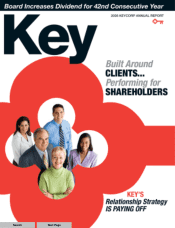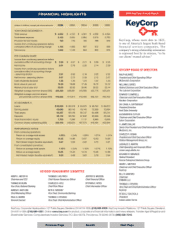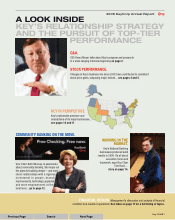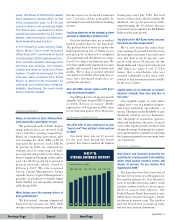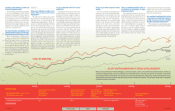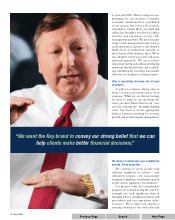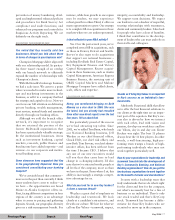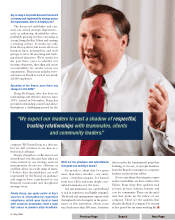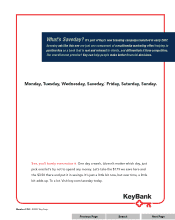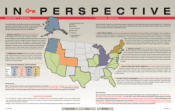KeyBank 2006 Annual Report Download - page 8
Download and view the complete annual report
Please find page 8 of the 2006 KeyBank annual report below. You can navigate through the pages in the report by either clicking on the pages listed below, or by using the keyword search tool below to find specific information within the annual report.
prevention of money laundering; devel-
oped and implemented enhanced policies
and procedures for Bank Secrecy Act
compliance and audit functions; and
enhanced our programs and controls for
Suspicious Activity Reporting. We are
definitely on the right track.
ADJUSTING THE BUSINESS MIX
You noted that Key recently sold two
businesses. Would you talk about those
in terms of changes in your business mix?
Champion Mortgage didn’t align well
with our relationship model. In particu-
lar, there wasn’t enough of an overlap
with our branch network to efficiently
expand the number of relationships with
Champion’s clients.
With McDonald’s brokerage business,
we had a scale issue. We came to a point
where we needed to make more technol-
ogy and marketing investments in the
business, or sell it to a company that had
the strategy and capital to do so. Now we
can focus our full attention on delivering
private banking, wealth management,
trust services, mutual funds and annuities
directly through our banking offices.
Although we sold the branch office
network, it’s important to recognize
that we retained the portion of the
former McDonald organization that
has been a particularly valuable strategic
fit: the institutional businesses. Areas
such as investment banking, capital
markets, research, public finance and
fixed income have added expertise – and
revenue – to our corporate and institu-
tional banking areas.
Some observers have suggested that Key
is too geographically dispersed. Have you
considered consolidating your banking
footprint?
We’ve certainly heard that comment –
more so in the past than currently. I think
many analysts have come to realize – as
we have – the opportunities our broad
Maine-to-Alaska footprint offers us.
First, facing different competitors in four
regions of the country is an advantage
when it comes to pricing and gathering
deposits. Second, our geographic diversity
gives us a risk-management benefit. For
instance, while loan growth in one region
may be modest, we may experience
robust growth in others.Third, it offers us
many opportunities to grow. Our strategy
is to complete fill-in acquisitions in those
markets where we are underrepresented.
Is that reflected in your M&A activity?
Yes. Over the past several years, we’ve
completed several fill-in acquisitions, such
as those in Denver, Detroit and Seattle.
But we’re also eager to do acquisitions
that support our national businesses –
including KeyBank Real Estate Capital,
Key Equipment Finance and Victory
Capital Management. Recent acquisi-
tions in these businesses, such as Austin
Capital Management, American Express
Business Finance, the servicing unit of
ORIX Capital Markets and Malone
Mortgage Company have added clients,
scale, offices and expertise.
LEADERSHIP AND VALUES
Henry, you mentioned bringing on Beth
Mooney as a vice chair in 2006. She was
the latest, but you already had recruited
three other new direct reports over the last
four years. Tell us about that.
I’m particularly proud of the success
we’ve had attracting top talent. Since
2001, we’ve added Tom Bunn, who heads
our National Banking business, Jeff
Weeden as our chief financial officer,
Chuck Hyle, our chief risk officer, and
now Beth. Tom Stevens, our chief admin-
istrative officer, has been with me from
the time I became CEO. I believe that
any one of our new executives would
tell you that they came here to lead
change in a changing industry. I’d also
note that we’ve attracted terrific people at
all levels of the company,moreso than
we have in the past. From where I sit, this
ability is increasingly a strategic compet-
itive advantage for us.
What do you look for in new Key leaders?
Is there a common thread?
Weplace a great deal of emphasis on
leadership and teamwork. We look
closely at a candidate’s attraction to, and
fitwith our culture. Wehirefor what we
call our Key Values – teamwork, respect,
integrity, accountability and leadership.
We support team decisions. We expect
our leaders to cast a shadow of respectful,
trusting relationships with teammates,
clients and community leaders. I also look
for people who have a dose of humility.
I think that contributes to the develop-
ment of leaders who can trust and rely on
their staffs and colleagues.
Sounds as if living Key Values is as important
to Key’s success as an individual’s func-
tional skills.
Absolutely. Functional skills that allow
us to offer the best financial solutions to
our clients at the right time are an impor-
tant partof the equation. But Key’ssuc-
cess also is driven by how we interact
with each other,lead with vision and
passion, develop our workforce and live
our Values, day in and day out. Knute
Rockne was right: The best 11 players
always beat the 11 best players. In other
words, a well-functioning, high-per-
forming team trumps a bunch of high-
performing individuals who may not
work together particularly well.
How do your expectations for leadership and
teamwork translate into the development of
Key’sCommunity Banking and National
Banking organizations? How do you get the
two business organizations to work together
for the benefitof clients and shareholders?
It starts with a leadership team that
truly understands that we do what’s right
for the client and best for the company,
not what’s necessarily best for a line of
business or an individual. There’s only
one stock traded and that’sKeyCorp
stock. Teamwork has become a differ-
entiator for those Key leaders who are
recruited or move up in the company.
Key 2006 57
Next Page
Search
Previous Page

